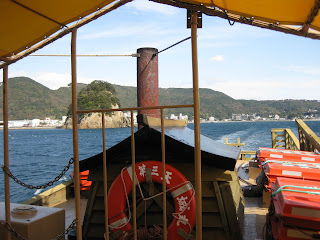Last weekend we had to see Kobe again. On the way we stopped to get a closer look at The Bridge we usually speed past on the way somewhere else.

An Australian callistemon bottlebrush grows on the pier under the huge Akashi Bridge. Akisho-Kaikyo O-Hashi is the world's longest suspension bridge (more than one-and-a-half Golden Gates.) It links Kobe (Honshu Island) with Iwaya (Awaji Island) and is one of a series which links Honshu to Shikoku across the Seto (Inland Sea.)

The Akashi Strait is a designated International Waterway which necessitated a minimum 1.5 km width unimpeded shipping lane. The distance between the two central pylons far exceeds this at 1.991 km. The overall length of the bridge is 3.9 km.

Sea-level view. The cables support a 6 lane expressway. Despite a toll of 2300 Yen (that's $A 36.56 at the current exchange), 23 000 cars use this crossing every day.

A separate service road and pedestrian walkway under the expressway.
The world-record 300 m. pylons are supported by equally monumental foundations, the biggest being 85 m wide and extending 65m below the sea-bed. That's a hell of a lot of concrete.

Bridge Under Construction. (Unknown photograher.)
Building began in 1986. When the disastrous Hanshin Earthquake struck in 95, the completed "twin towers" were moved apart more than a metre. After some quick recalculations the main span was infinitessimally widened. The bridge was completed in 1998.

My shoe appears bigger than the fishing boat 8 stories below the glass decking.

Even knowing the thick glass has withstood thousands of feet over ten years, there's still a slight feeling of vertigo seeing the sea so far below...

Viewed through the hole in this monument the bridge doesn't look all that big. You wouldn't know that those "thin" supporting cables are 1.1 metres thick or that they contain 300 000 kms of wire!

The Japanese are justifiably proud of
Akashi O-Hashi. One of the early motivations for its construction was the sinking of two ferries in the 50s which resulted in the loss of 168 children. The bridge has been designed to withstand typhoons of 286 km/h and earthquakes measuring up to 8.5 (Richter.)









































.JPG)
.JPG)













